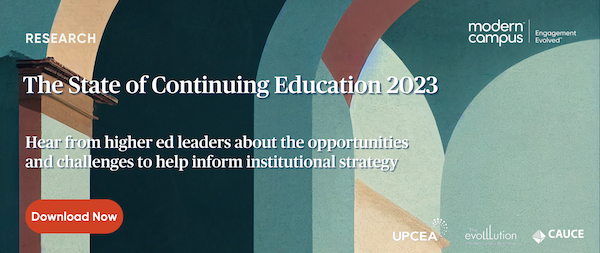Published on
Driving Success With Continuing Education’s Lifelong Learning Model

Continuing Education units are historically known to being siloed from the broader institution, but learners’ changing needs have led CE to begin driving the innovation institutions need to survive and thrive in this new environment. To meet these new needs, it’s critical for higher ed leaders to work in tandem with CE. In this interview, Sydney Beeler discusses the history behind the CE’s silo, what makes it stand out and how it can help the larger institution.
The EvoLLLution (Evo): Why have CE units historically been siloed?
Sydney Beeler (SB): Historically, CE units were siloed because of the way CE developed at colleges and universities. As practitioners, we must keep in mind that colleges in the United States were developed from a desire to educate young upper-middle-class men. Thus education and broader system were driven toward a younger and more traditional population.
Conversely, Continuing Education was driven toward an adult population, initially as weekly discussion sessions Benjamin Franklin set up (Lynch-Morin, 2013). Throughout history, Continuing Education evolved in tight alignment with adult learners’ specific needs, growing in the 20th century as a result of the Extension Movement, Industrial Revolution, the Higher Education Act, the GI Bill, Civil Rights movement and other historical events that ultimately drove learners into Continuing Education. Continuing Education was learner-focused and provided access to education for populations who may not have historically had it within the traditional framework. Further, Continuing Education developed its own identity outside the traditional college/university context, and this identity of accessibility has remained intact.
Consequently, from the perspective of organizational development, there was a need to create different departments, separate leadership and various processes to serve these learners. Some would argue that CE being siloed or decentralized is a strength, as CE is not left to operate within the confines of the collegial system. However, at a time when learners have choices, when there are labor market shortages and people need family-sustaining wages, I believe the strength that once came from being siloed has diminished, and CE needs to be connected to a skill or career pathway, so our adult learners can stay in the workforce and continue to learn simultaneously.
Evo: What are the key qualities that make a CE unit stand out?
SB: Continuing Education programs have the unique ability to observe a need or market demand and quickly adapt to it. In other words, CE can meet learners where they are and do so quickly. This is especially important as our traditional college/university system undertakes extensive curricular review processes that our workforce and industry partners often view as unresponsive.
The technology available to assist our learners and our program coordinators, like Modern Campus Lumens, makes that adaptation even easier. Lumens facilitates program and course development and serves our learners well through on-demand access.
Evo: What challenges come with CE sitting outside the institution?
SB: While CE, in operating in a silo outside the traditional college/university context, is able to adapt quickly to its learners and to the market, there are challenges and disadvantages. As we approach the demographic cliff for enrollment in 2025, institutions will be scrambling to react and proactively plan, and college and university leadership will be searching for ways to fund their strategic plans. Continuing Education, if an integral part of the institution, can play a role in accomplishing the goals laid out in strategic plans through their connections to the community, programming for adult learners and workforce engagement. However, if they are disconnected from the strategic plan’s activities, then they may have a hard time justifying their budget allocation and positive impact to the institution. Further, an institution is strengthened when all its units are aligned and tightly coupled with goals in the strategic plan. Thus, there is symbiotic strength in Continuing Education having a seat at the table and being an integral part of serving learners are served that is valuable to our institutions, to our CE programs and most importantly to our learners.
Evo: What are some best practices for CE to get a seat at the table when it comes to the broader institutional strategy?
SB: As our learners have changed, I believe CE is perfectly poised to be at the table. As practitioners, we must realize that our learners have changed, and higher education must meet them where they are, i.e., online, short-term programs and classes for upskilling. This is Continuing Education’s specialty. CE should align its specialties with the institution’s strategic plan to demonstrate their impact.
Further, CE should continue to listen to community, business and industry needs, and respond quickly to the needs expressed. CE must remain adaptable and courageous in being innovative and entrepreneurial.
As our world continues to change as a result of technology’s monumental disruption, it is more important than ever that CE takes its place at the table to help institutions respond to emerging needs and nimbly address the skills gaps in our workforce.
Evo: How can CE leverage its uniqueness to better position the institution for success?
SB: CE’s nature to view learning as a lifelong continuum is critical. Assessing and reviewing the markets, addressing the skills gaps and creating partnerships will help higher education institutions remain relevant to the communities and industries they serve. CE, through its flexible nature, can also meet learners in a variety of modalities and on a variety of subjects. All the aforementioned characteristics position CE to help leverage their institution’s success.
Moreover, as our population is living longer and CE fuels lifelong learning, there is an ever-expanding market that will continue to evolve.
Evo: Is there anything you’d like to add about the CE’s uniqueness or shifting that mindset to seeing students as lifelong learners?
SB: I learned last summer, at a conference, to reframe our students as learners to think outside the box (our traditional higher education box). Our nation and the landscape of higher education are changing rapidly, as are our students. By viewing them as learners, CE is uniquely positioned to innovate and adapt.
As our learners will continue to change, CE has the ability to open up a whole new world of learning to them and continue to align its mission and serve communities of all ages. It allows CE to continue to be the institution’s entrepreneurial arm.
This interview was edited for length and clarity.

Author Perspective: Administrator
Author Perspective: Community College



